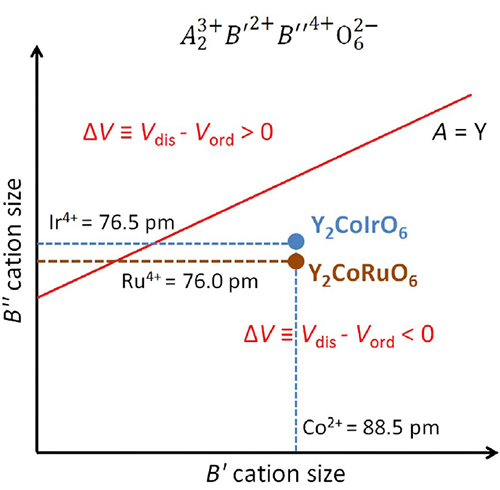Challenging Chemical Intuition: Pressure Induced Abnormal Phase Transition
Date:26-05-2020 Print
High pressure technique is one of the most important methods to discover materials with exotic properties since it can synthesize new phases that can be recovered as metastable phases at ambient. While these phases cannot be fabricated by conventional methods. High pressure is prevailing in nature. The interior of all planets are ubiquity within ultra high pressure. Thus studies of the properties under pressures are essential to enrich our knowledge of the mystic Universe. Perovskite structure is the most common prototype form for functional materials, while also the main constituent of the Earth Mantle. Consequently, studies of pressure correlated perovskite structures are of great significance. Prof. Jin's team, from Institute of Physics CAS/Beijing National Laboratory for Condensed Matter Physics, has worked on perovskite like new materials by design using high pressure synthesis for long time. With advanced new highpressure techniques, they designed and successfully fabricated a serial of new functional materials with perovskitelike structures (Nature 375, 301(1995), PNAS 105, 7115(2008), PNAS 116, 12156 (2019)).
Order disorder effects in materials are of fundamental interest to solid state sciences. Polymorphs with identical chemical formula, but different ordering degrees, can alter crystal symmetry dramatically and hence modify properties like stability, magnetism, thermo-and electrical transport, elasticity, etc. Usually order disorder transitions are controlled by temperature or compositions. In addition, pressure has also been applied to modify atomic ordering with remarkable efficiency, thanks to the advancement of high pressure techniques.
Very recently, Prof. Jin's team made important progress on new type of perovskite compounds, namely the double perovskites A2B'B''O6, synthesized under extremely high-pressures. For most of known materials, pressure tends to increase number of coordination, and hence make a structure ordered. Chemical intuition tells us that the disordered phases will have larger lattice volumes since the distance of neighboring B''-B'' will be additionally enlarged owing to strong Coulomb repulsion. As a result, B-site disordered cannot be stabilized under high pressure. Previous reports indeed confirmed that pressure always increase B-site ordering. Associate professor Zheng Deng, Dr. Wenmin Li, Dr. Jianfa Zhao from Prof. Jin’s team synthesized a new B-sited ordered double perovskite Y2CoIrO6, and further discovered pressure-induced B-site disordering phenomena. With increasing synthesis pressures, the material showed B-sited order (at 0GPa), partial order (at 6GPa) and complete disorder (at 15GPa). It is interesting that 15 GPa corresponds to the pressure around boundary region between upper Mantle and lower Mantle wherein many perovskite materials form. Along with the transition from ordered structure to disordered one, the magnetic property changes from long-range ferrimangenet to short-range spin-glass-like state. The origin of the pressure induced inverse order disorder transition is that the disordered phase has smaller unit cell volume due to the unique combination of B'-O and B''-O bond strength, namely orbital hybridizations. The physical mechanism is supported by the theory calculations based on built-up of thermo-statistical model.
The study is published on Angewandte Chemie-International Edition as cover-page paper and hot paper (DOI:10.1002/anie.202001922; Angewandte Chemie-International 59, 8240 (2020)). The discovery of counter chemical intuition will lead to reconsideration of the effects of pressures in solid state sciences, as highlighted in the coverpage guideline of Angewandte Chemie-International. The research is benefited from the collaborations with Profs. Greenblatt and Kotliar from Rutgers University, Prof. Richeng Yu from IOPCAS, etc. The study is supported by MOST and NSF of China, and the Youth Innovation Promotion Association of CAS (2018YFA03057001, 2017YFB0405703, 11921004, 11820101003, 11974407 and 2020007).

Figure 1. Cover page story of Angewandte Chemie for this work

Figure 2. Y2CoIrO6 synthesized under different pressures have varying B-site ordering and hence different magnetism.

Figure 3. The phase diagram of double perovskites, Y2CoIrO6 is in the region of pressure-induced disordering.
Contact:
Institute of Physics
JIN Changqing
Email:jin@iphy.ac.cn
Key word:
double perovskites, lattice compression, pressure-induced B-site disorder, statistical model
Abstract:
Given the consensus that pressure improves cation ordering in most of known materials, a discovery of pressure-induced disordering could require recognition of an order--disorder transition in solid-state physics/chemistry and geophysics. Double perovskites Y2CoIrO6 and Y2CoRuO6 polymorphs synthesized at 0, 6, and 15 GPa show B-site ordering, partial ordering, and disordering, respectively, accompanied by lattice compression and crystal structure alteration from monoclinic to orthorhombic symmetry. Correspondingly, the long-range ferrimagnetic ordering in the B-site ordered samples are gradually overwhelmed by B-site disorder. Theoretical calculations suggest that unusual unit-cell compressions under external pressures unexpectedly stabilize the disordered phases of Y2CoIrO6 and Y2CoRuO6.

